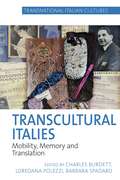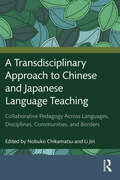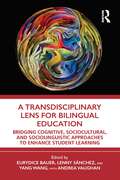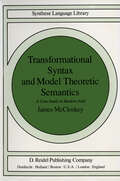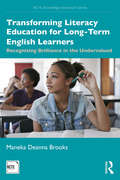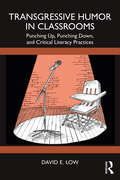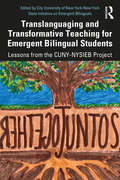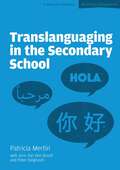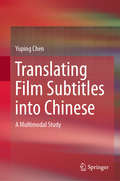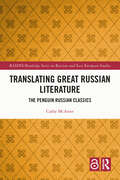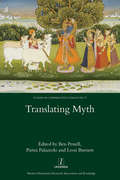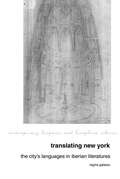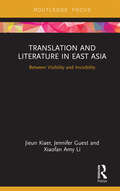- Table View
- List View
Transcultural Italies: Mobility, Memory and Translation (Transnational Italian Cultures #4)
The history of Italians and of modern Italian culture stems from multiple experiences of mobility and migration: between the late 19th century and the early 20th century, 27 million Italians migrated and 60 to 80 million people worldwide see their identity as connected with the Italian diaspora. Since the time of Italian unification, a series of narratives about mobility have been produced both inside and outside the boundaries of Italy, by agents such as the Italian state, international organizations or migrant communities themselves.The essays in Transcultural Italies follow the multiple trajectories of this complex history and of its representations. They do so by focusing on the key concepts and practices of mobility, memory and translation. Taken together, they represent a contrapuntal series of case studies that offers a fresh perspective on the study of modern and contemporary Italy. The essays in the volume explore the meanings that ‘transnational’ and ‘transcultural’ assume when applied to the notion of Italian culture.Contributors: Charles Burdett, Jennifer Burns, Derek Duncan, Chiara Giuliani, Viviana Gravano, Giulia Grechi, Margaret Hills de Zárate, Eliana Maestri, Valerie McGuire, Loredana Polezzi, Barbara Spadaro, Ilaria Vanni, Naomi Wells, Rita Wilson
A Transdisciplinary Approach to Chinese and Japanese Language Teaching: Collaborative Pedagogy Across Languages, Disciplines, Communities, and Borders
by Nobuko Chikamatsu Li JinA Transdisciplinary Approach to Chinese and Japanese Language Teaching illustrates how the transdisciplinary approach to second language acquisition (SLA) centers around collaboration to provide a learning-conducive environment with rich semiotic resources for second/foreign language learners. The volume consists of 14 chapters from leading experts in SLA and Chinese and Japanese language educators from Canada, China, Japan, the United Kingdom, and the United States of America. As a first work of its kind, the contributions feature both theoretical interpretations of transdisciplinary concepts that can apply to Chinese/Japanese as a second language learning and case studies showcasing how college-level Chinese and Japanese language educators design and implement pedagogical projects in collaboration with partners across languages, disciplines, communities, and borders by adopting a transdisciplinary perspective to analyze students’ learning outcomes. This book will benefit researchers, administrators, educators, and teacher educators in higher education with an interest in world language education and interdisciplinary and project-based teaching.
A Transdisciplinary Approach to Chinese and Japanese Language Teaching: Collaborative Pedagogy Across Languages, Disciplines, Communities, and Borders
A Transdisciplinary Approach to Chinese and Japanese Language Teaching illustrates how the transdisciplinary approach to second language acquisition (SLA) centers around collaboration to provide a learning-conducive environment with rich semiotic resources for second/foreign language learners. The volume consists of 14 chapters from leading experts in SLA and Chinese and Japanese language educators from Canada, China, Japan, the United Kingdom, and the United States of America. As a first work of its kind, the contributions feature both theoretical interpretations of transdisciplinary concepts that can apply to Chinese/Japanese as a second language learning and case studies showcasing how college-level Chinese and Japanese language educators design and implement pedagogical projects in collaboration with partners across languages, disciplines, communities, and borders by adopting a transdisciplinary perspective to analyze students’ learning outcomes. This book will benefit researchers, administrators, educators, and teacher educators in higher education with an interest in world language education and interdisciplinary and project-based teaching.
A Transdisciplinary Lens for Bilingual Education: Bridging Cognitive, Sociocultural, and Sociolinguistic Approaches to Enhance Student Learning
by Eurydice Bauer Lenny Sánchez Yang Wang Andrea VaughanAddressing the intersections between cognitive, sociocultural, and sociolinguistic research, this volume explores bilingual development across educational contexts to discuss and uncover the influences and impact of language in school programming and everyday practices. Confronting a standard monolingual lens, this collection highlights the importance of applying cross-disciplinary approaches to examine bilingualism in relation to topics such as language politics, linguistic identities, students’ experiences at home and in schools, asset-based teaching and curricula, and overall benefits. Ideal for courses in bilingualism, literacy, psychology, and language education, this text is an important resource for understanding and applying transdisciplinary, inclusive approaches to positively influence cognitive development, academic learning, and identity formation in bilingual education.
A Transdisciplinary Lens for Bilingual Education: Bridging Cognitive, Sociocultural, and Sociolinguistic Approaches to Enhance Student Learning
by Eurydice Bauer Lenny Sánchez Yang Wang Andrea VaughanAddressing the intersections between cognitive, sociocultural, and sociolinguistic research, this volume explores bilingual development across educational contexts to discuss and uncover the influences and impact of language in school programming and everyday practices. Confronting a standard monolingual lens, this collection highlights the importance of applying cross-disciplinary approaches to examine bilingualism in relation to topics such as language politics, linguistic identities, students’ experiences at home and in schools, asset-based teaching and curricula, and overall benefits. Ideal for courses in bilingualism, literacy, psychology, and language education, this text is an important resource for understanding and applying transdisciplinary, inclusive approaches to positively influence cognitive development, academic learning, and identity formation in bilingual education.
Transformational Syntax and Model Theoretic Semantics: A Case Study in Modern Irish (Studies in Linguistics and Philosophy #9)
by J. McCloskeyThis piece of work began life as a doctoral thesis written at the University of Texas between 1976 and 1978. Now after a year in Dublin it is to become a book. Of the many people in the Department of Linguistics at Texas who shaped my interests and who helped me through the writing of the thesis, I must single out Lee Baker, Lauri Karttunen, Bill Ladusaw, Sue Schmerling and Stanley Peters for special gratitude. All of them have provided specific suggestions which have improved this work, but perhaps more .importantly they provided a uniquely stimulating and harmonious environment in which to work, and a demanding set of professional standards to live up to. To Ken Hale lowe a particular debt of gratitude - for two years of encour agement and suggestions, and particularly for a set of detailed comments on an earlier version of the book which led to many changes for the better. I also thank my friends Per-Kristian Halvorsen and Elisabet Engdahl, both of whom took the trouble to provide me with detailed criticisms and comments. In Dublin I am grateful to the School of Celtic Studies of the Institute for Advanced Studies for giving me the opportunity of teaching a seminar on many of the topics covered in the book and of exposing the material to people whose knowledge of the language is unequalled. Donal 6 Baoill and Liam Breatnach have been particularly helpful.
Transforming Hanzi Pedagogy in the Digital Age: 电写时代的汉字教学: 理论与实践
by Chengzhi Chu Matthew D. Coss Phyllis N. ZhangTransforming Hanzi Pedagogy in the Digital Age 电写时代的汉字教学 brings together expert researchers and practitioners to offer a coherent theoretical, empirical, pedagogical, and experiential justification for a shift in pedagogical focus from handwriting to e-writing in L2 Chinese pedagogy.This volume argues for a pedagogy based on the 21st century communicative needs of L2 Chinese users, grounded in empirical research as well as practical and lived experiences. The authors propose an “e-writing as primary” (电写为主,手写为辅) framework for L2 Chinese instruction in the 21st century, a transformational proposal which will fundamentally shift the pedagogical focus of L2 Chinese instruction globally towards more learner-centered, research-informed practice. This volume includes three theoretical foundation chapters, four empirical studies, three descriptions of program-level implementation, and ten expert L2 Chinese user vignettes, which, taken together, offer a thorough introduction to e-writing for the future of L2 Chinese teaching and learning.This book will be informative for Chinese language instructors, researchers, program directors, materials developers, and advanced graduate students in both CFL and CSL contexts worldwide.
Transforming Hanzi Pedagogy in the Digital Age: 电写时代的汉字教学: 理论与实践
by Chengzhi Chu Matthew D. Coss Phyllis N. ZhangTransforming Hanzi Pedagogy in the Digital Age 电写时代的汉字教学 brings together expert researchers and practitioners to offer a coherent theoretical, empirical, pedagogical, and experiential justification for a shift in pedagogical focus from handwriting to e-writing in L2 Chinese pedagogy.This volume argues for a pedagogy based on the 21st century communicative needs of L2 Chinese users, grounded in empirical research as well as practical and lived experiences. The authors propose an “e-writing as primary” (电写为主,手写为辅) framework for L2 Chinese instruction in the 21st century, a transformational proposal which will fundamentally shift the pedagogical focus of L2 Chinese instruction globally towards more learner-centered, research-informed practice. This volume includes three theoretical foundation chapters, four empirical studies, three descriptions of program-level implementation, and ten expert L2 Chinese user vignettes, which, taken together, offer a thorough introduction to e-writing for the future of L2 Chinese teaching and learning.This book will be informative for Chinese language instructors, researchers, program directors, materials developers, and advanced graduate students in both CFL and CSL contexts worldwide.
Transforming Literacy Education for Long-Term English Learners: Recognizing Brilliance in the Undervalued (NCTE-Routledge Research Series)
by Maneka Deanna BrooksGrounded in research on bilingualism and adolescent literacy, this volume provides a much-needed insight into the day-to-day needs of students who are identified as long-term English language learners (LTELs). LTELs are adolescents who are primarily or solely educated in the U.S. and yet remain identified as "learning English" in secondary school. Challenging the deficit perspective that is often applied to their experiences of language learning, Brooks counters incorrect characterizations of LTELs and sheds light on students’ strengths to argue that effective literacy education requires looking beyond policy classifications that are often used to guide educational decisions for this population. By combining research, theory, and practice, this book offers a comprehensive analysis of literacy pedagogy to facilitate teacher learning and includes practical takeaways and implications for classroom practice and professional development. Offering a pathway for transforming literacy education for students identified as LTELs, chapters discuss reframing the education of LTELs, academic reading in the classroom, and the bilingualism of students who are labeled LTELs. Transforming Literacy Education for Long-Term English Learners is a much-needed resource for scholars, professors, researchers, and graduate students in language and literacy education, English education, and teacher education, and for those who are looking to create an inclusive and successful classroom environment for LTELs.
Transforming Literacy Education for Long-Term English Learners: Recognizing Brilliance in the Undervalued (NCTE-Routledge Research Series)
by Maneka Deanna BrooksGrounded in research on bilingualism and adolescent literacy, this volume provides a much-needed insight into the day-to-day needs of students who are identified as long-term English language learners (LTELs). LTELs are adolescents who are primarily or solely educated in the U.S. and yet remain identified as "learning English" in secondary school. Challenging the deficit perspective that is often applied to their experiences of language learning, Brooks counters incorrect characterizations of LTELs and sheds light on students’ strengths to argue that effective literacy education requires looking beyond policy classifications that are often used to guide educational decisions for this population. By combining research, theory, and practice, this book offers a comprehensive analysis of literacy pedagogy to facilitate teacher learning and includes practical takeaways and implications for classroom practice and professional development. Offering a pathway for transforming literacy education for students identified as LTELs, chapters discuss reframing the education of LTELs, academic reading in the classroom, and the bilingualism of students who are labeled LTELs. Transforming Literacy Education for Long-Term English Learners is a much-needed resource for scholars, professors, researchers, and graduate students in language and literacy education, English education, and teacher education, and for those who are looking to create an inclusive and successful classroom environment for LTELs.
Transgressive Humor in Classrooms: Punching Up, Punching Down, and Critical Literacy Practices
by David E. LowIn this innovative book, David E. Low examines the multifaceted role of humor in critical literacy studies. Talking about how teachers and students negotiate understandings of humor and social critique vis-à-vis school-based critical literacy curriculums, the book co-examines teachers’ and students’ understandings of humor and critique in schools.Critical literacy centers discussions on power and social roles but often overlooks how students use transgressive humor as a means to interrogate power. Through examples of classroom interactions and anecdotes, Low analyzes the role of humor in classroom settings to uncover how humor interplays with critical inquiry, sensemaking, and nonsense-making. Articulated across the fields of literacy studies and humor studies, the book uses ethnographic data from three Central California high schools to establish linkages and dissonances between critical literacy education and adolescents’ joking practices. Adopting the dialectic of punching up and punching down as a conceptual framework, the book argues that developing more nuanced understandings of transgressive humor presents educators with opportunities to cultivate deeper critical literacy pedagogies and that doing so is a matter of social justice.Essential for scholars and students in literacy education, this book adds to the scholarship on critical literacy by exploring the subversive power of humor in the classroom.
Transgressive Humor in Classrooms: Punching Up, Punching Down, and Critical Literacy Practices
by David E. LowIn this innovative book, David E. Low examines the multifaceted role of humor in critical literacy studies. Talking about how teachers and students negotiate understandings of humor and social critique vis-à-vis school-based critical literacy curriculums, the book co-examines teachers’ and students’ understandings of humor and critique in schools.Critical literacy centers discussions on power and social roles but often overlooks how students use transgressive humor as a means to interrogate power. Through examples of classroom interactions and anecdotes, Low analyzes the role of humor in classroom settings to uncover how humor interplays with critical inquiry, sensemaking, and nonsense-making. Articulated across the fields of literacy studies and humor studies, the book uses ethnographic data from three Central California high schools to establish linkages and dissonances between critical literacy education and adolescents’ joking practices. Adopting the dialectic of punching up and punching down as a conceptual framework, the book argues that developing more nuanced understandings of transgressive humor presents educators with opportunities to cultivate deeper critical literacy pedagogies and that doing so is a matter of social justice.Essential for scholars and students in literacy education, this book adds to the scholarship on critical literacy by exploring the subversive power of humor in the classroom.
Translanguaging and Transformative Teaching for Emergent Bilingual Students: Lessons from the CUNY-NYSIEB Project
by City University City University of New York-New York State Initiative on Emergent BilingualsA critical and accessible text, this book provides a foundation for translanguaging theory and practice with educating emergent bilingual students. The product of the internationally renowned and trailblazing City University of New York-New York State Initiative on Emergent Bilinguals (CUNY-NYSIEB), this book draws on a common vision of translanguaging to present different perspectives of its practice and outcomes in real schools. It tells the story of the collaborative project’s positive impact on instruction and assessment in different contexts, and explores the potential for transformation in teacher education. Acknowledging oppressive traditions and obstacles facing language minoritized students, this book provides a pathway for combatting racism, monolingualism, classism and colonialism in the classroom and offers narratives, strategies and pedagogical practices to liberate and engage emergent bilingual students. This book is an essential text for all teacher educators, researchers, scholars, and students in TESOL and bilingual education, as well as educators working with language minoritized students.
Translanguaging and Transformative Teaching for Emergent Bilingual Students: Lessons from the CUNY-NYSIEB Project
by Ofelia GarcíaA critical and accessible text, this book provides a foundation for translanguaging theory and practice with educating emergent bilingual students. The product of the internationally renowned and trailblazing City University of New York-New York State Initiative on Emergent Bilinguals (CUNY-NYSIEB), this book draws on a common vision of translanguaging to present different perspectives of its practice and outcomes in real schools. It tells the story of the collaborative project’s positive impact on instruction and assessment in different contexts, and explores the potential for transformation in teacher education. Acknowledging oppressive traditions and obstacles facing language minoritized students, this book provides a pathway for combatting racism, monolingualism, classism and colonialism in the classroom and offers narratives, strategies and pedagogical practices to liberate and engage emergent bilingual students. This book is an essential text for all teacher educators, researchers, scholars, and students in TESOL and bilingual education, as well as educators working with language minoritized students.
Translanguaging in EFL Contexts: A Call for Change (Routledge Research in Language Education)
by Michael RabbidgeThe purpose of this book is to promote the value of translanguaging in EFL teaching contexts. To date, translanguaging has been discussed mostly in regards to US and European contexts. This book will examine the teaching beliefs and practices of teachers within a South Korean elementary school context to evaluate the practices of current teachers who use translanguaging strategies when teaching. This examination utilizes sociological theories of pedagogic discourse to discuss the consequences of language exclusion policies on the peninsula. Using these theories, it presents an argument for why EFL contexts like South Korea need to reevaluate their current policies and understandings of language learning and teaching. By embracing translanguaging as an approach, the author argues, they will transform their traditional notions of language learning and teaching in order to view teachers as bilinguals, and learners as emerging bilinguals, rather than use terms of deficiency that have traditionally been in place for such contexts. This book's unique use of sociological theories of pedagogic discourse supports a need to promote the translanguaging ideology of language teaching and learning.
Translanguaging in EFL Contexts: A Call for Change (Routledge Research in Language Education)
by Michael RabbidgeThe purpose of this book is to promote the value of translanguaging in EFL teaching contexts. To date, translanguaging has been discussed mostly in regards to US and European contexts. This book will examine the teaching beliefs and practices of teachers within a South Korean elementary school context to evaluate the practices of current teachers who use translanguaging strategies when teaching. This examination utilizes sociological theories of pedagogic discourse to discuss the consequences of language exclusion policies on the peninsula. Using these theories, it presents an argument for why EFL contexts like South Korea need to reevaluate their current policies and understandings of language learning and teaching. By embracing translanguaging as an approach, the author argues, they will transform their traditional notions of language learning and teaching in order to view teachers as bilinguals, and learners as emerging bilinguals, rather than use terms of deficiency that have traditionally been in place for such contexts. This book's unique use of sociological theories of pedagogic discourse supports a need to promote the translanguaging ideology of language teaching and learning.
Translanguaging in the Secondary School
by Patricia MertinIn schools across the world, there are large numbers of students who are not native speakers of the language of instruction in their classroom. This leads to challenges for the teachers, students and parents. Translanguaging enables students who are second language leaners to build on previous learning, access the curriculum more effectively, learn with greater depth of understanding, improve their ability to speak and write the academic language of instruction and continue to develop their mother tongue. This book describes the origin and development of translanguaging. It explains the present situation in many secondary schools and the challenges which are faced by teachers, students and their parents. It aligns the power of translanguaging with cognitive psychologists' theories of effective learning. Concrete suggestions are offered to support teaching and learning with real examples from practice given by classroom teachers.
Translating Film Subtitles into Chinese: A Multimodal Study
by Yuping ChenThis book examines three metafunction meanings in subtitle translation with three research foci, i.e., the main types of cross-modal interrelation, the primary function of semiotic interplay, and the key linguistic components influencing the subtitles. It goes beyond traditional textual analysis in translation studies; approaches subtitle translation from a multimodality standpoint; and breaks through the linguistic restraints on subtitling research by underscoring the role of semiotic interplay. In the field of multimodality, this book bridges subtitling and multimodality by investigating the interweaving relationships between different semiotic modes, and their corresponding impacts on subtitle translation.
Translating Great Russian Literature: The Penguin Russian Classics (ISSN)
by Cathy McAteerLaunched in 1950, Penguin’s Russian Classics quickly progressed to include translations of many great works of Russian literature and the series came to be regarded by readers, both academic and general, as the de facto provider of classic Russian literature in English translation, the legacy of which reputation resonates right up to the present day. Through an analysis of the individuals involved, their agendas, and their socio-cultural context, this book, based on extensive original research, examines how Penguin’s decisions and practices when translating and publishing the series played a significant role in deciding how Russian literature would be produced and marketed in English translation. As such the book represents a major contribution to Translation Studies, to the study of Russian literature, to book history and to the history of publishing.
Translating Great Russian Literature: The Penguin Russian Classics (ISSN)
by Cathy McAteerLaunched in 1950, Penguin’s Russian Classics quickly progressed to include translations of many great works of Russian literature and the series came to be regarded by readers, both academic and general, as the de facto provider of classic Russian literature in English translation, the legacy of which reputation resonates right up to the present day. Through an analysis of the individuals involved, their agendas, and their socio-cultural context, this book, based on extensive original research, examines how Penguin’s decisions and practices when translating and publishing the series played a significant role in deciding how Russian literature would be produced and marketed in English translation. As such the book represents a major contribution to Translation Studies, to the study of Russian literature, to book history and to the history of publishing.
Translating Myth (Legenda)
by Ben Pestell Pietra Palazzolo Le On BurnettEver since Odysseus heard tales of his own exploits being retold among strangers, audiences and readers have been alive to the complications and questions arising from the translation of myth. How are myths taken and carried over into new languages, new civilizations, or new media? An international group of scholars is gathered in this volume to present diverse but connected case studies which address the artistic and political implications of the changing condition of myth – this most primal and malleable of forms. ‘Translation’ is treated broadly to encompass not only literary translation, but also the transfer of myth across cultures and epochs. In an age when the spiritual world is in crisis, Translating Myth constitutes a timely exploration of myth’s endurance, and represents a consolidation of the status of myth studies as a discipline in its own right.
Translating Myth (Legenda)
by Ben Pestell Pietra Palazzolo Leon BurnettEver since Odysseus heard tales of his own exploits being retold among strangers, audiences and readers have been alive to the complications and questions arising from the translation of myth. How are myths taken and carried over into new languages, new civilizations, or new media? An international group of scholars is gathered in this volume to present diverse but connected case studies which address the artistic and political implications of the changing condition of myth – this most primal and malleable of forms. ‘Translation’ is treated broadly to encompass not only literary translation, but also the transfer of myth across cultures and epochs. In an age when the spiritual world is in crisis, Translating Myth constitutes a timely exploration of myth’s endurance, and represents a consolidation of the status of myth studies as a discipline in its own right.
Translating New York: The City's Languages in Iberian Literatures (Contemporary Hispanic and Lusophone Cultures #17)
by Regina GalassoThe cultural production of Spanish-speaking New York is closely linked to the Caribbean and to Latin America at large, but the city also plays a pivotal role in the work of a host of authors from the Iberian Peninsula, writing in Spanish, Catalan, and English. In many cases, their New York City texts have marked their careers and the history of their national literatures. Drawing from a variety of genres, Translating New York recovers cultural narratives occluded by single linguistic or national literary histories, and proposes that reading these texts through the lens of translation unveils new pathways of cultural circulation and influence. Looking beyond representations of the city's physical space, Translating New York suggests that travel to the city and contact with New York's multilingual setting ignited a heightened sensitivity towards both the verbal and non-verbal languages of the city, garnering literary achievement and aesthetic innovation. Analyzing the novels, poetry, and travel narratives of Felipe Alfau, José Moreno Villa, Julio Camba, and Josep Pla, this book uncovers an international perspective of Iberian literatures. Translating New York aims to rethink Iberian literatures through the transatlantic travels of influential writers.The pre-publication version of Translating New York was awarded the 2017 Northeast Modern Language Association Book Award for the best unpublished book-length manuscript on modern language literature.
Translation: Translation, Illustration, Interpretation (Very Short Introductions)
by Matthew ReynoldsTranslation is everywhere, and matters to everybody. Translation doesn't only give us foreign news, dubbed films and instructions for using the microwave: without it, there would be no world religions, and our literatures, our cultures, and our languages would be unrecognisable. In this Very Short Introduction, Matthew Reynolds gives an authoritative and thought-provoking account of the field, from ancient Akkadian to World English, from St Jerome to Google Translate. He shows how translation determines meaning, how it matters in commerce, empire, conflict and resistance, and why it is fundamental to literature and the arts. ABOUT THE SERIES: The Very Short Introductions series from Oxford University Press contains hundreds of titles in almost every subject area. These pocket-sized books are the perfect way to get ahead in a new subject quickly. Our expert authors combine facts, analysis, perspective, new ideas, and enthusiasm to make interesting and challenging topics highly readable.
Translation and Literature in East Asia: Between Visibility and Invisibility
by Jieun Kiaer Jennifer Guest Xiaofan Amy LiTranslation and Literature in East Asia: Between Visibility and Invisibility explores the issues involved in translation between Chinese, Japanese and Korean, as well as from these languages into European languages, with an eye to comparing the cultures of translation within East Asia and tracking some of their complex interrelationships. This book reasserts the need for a paradigm shift in translation theory that looks beyond European languages and furthers existing work in this field by encompassing a wider range of literature and scholarship in East Asia. Translation and Literature in East Asia brings together material dedicated to the theory and practice of translation between and from East Asian languages for the first time.
